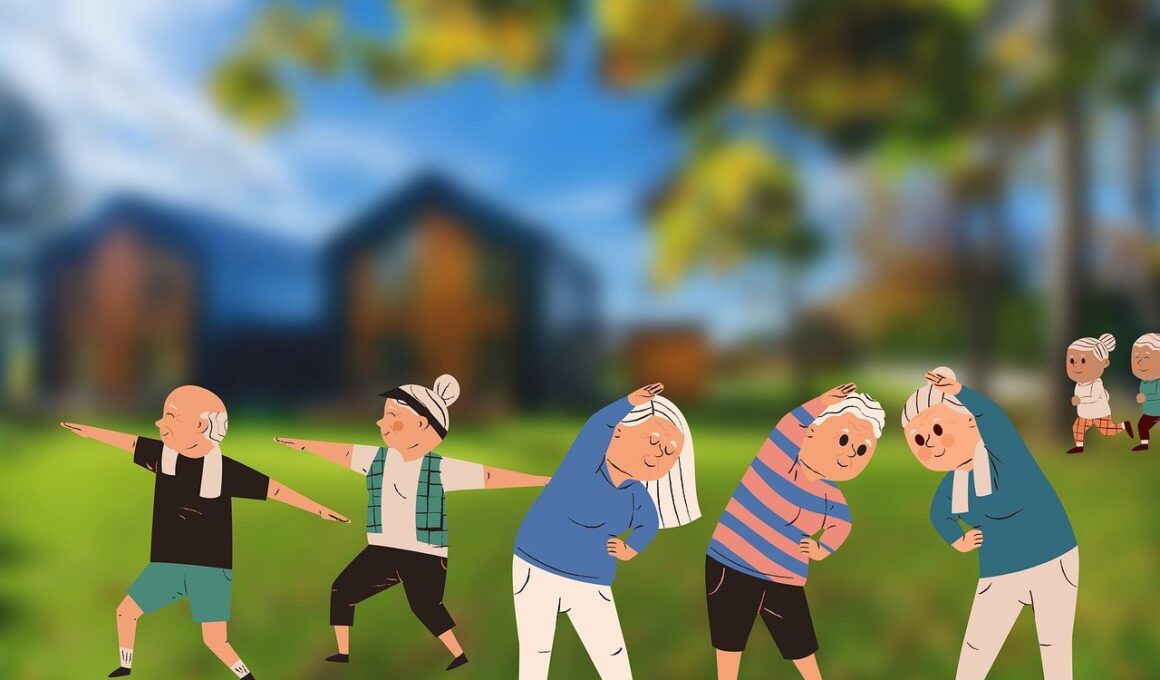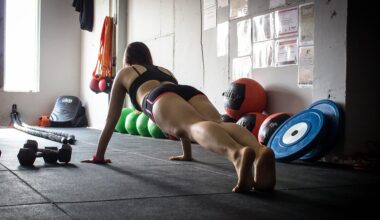Balancing Intensity and Safety in Senior CrossFit Training
For seniors beginning their journey into CrossFit, understanding the delicate balance between intensity and safety is paramount. Senior athletes often face unique challenges, including potential mobility limitations and varying health conditions. Prior to starting, it’s wise for seniors to consult with healthcare professionals, ensuring that their training is tailored to their individual fitness level. Enlisting the guidance of a certified CrossFit coach who possesses experience working with older adults can further ensure a safe and effective progression. In the gym, seniors may benefit from adjustments in workload and exercise selection, focusing on low-impact movements that still provide ample resistance. For example, utilizing resistance bands and modified bodyweight exercises can yield effective results while minimizing strain on joints. Maintaining a strong emphasis on proper form can significantly reduce the risk of injury. Additionally, incorporating appropriate warm-up routines gradually prepares the body for increased activity. Therefore, being mindful of personal limits and establishing a strong foundation in strength and mobility will yield long-term benefits, helping seniors embrace the CrossFit lifestyle with enthusiasm and confidence.
Group classes and communal support can enhance the experience of seniors participating in CrossFit. The motivation and camaraderie found in a team setting often create an encouraging atmosphere for older adults. Not only does this improve adherence to fitness regimens, but it also fosters social connections that combat loneliness and isolation. Senior-friendly CrossFit classes usually implement modified workout plans, ensuring that exercises are accessible for varying fitness levels. Coaches can use progressive scaling methods, adapting exercises for those just starting, ensuring that everyone can work towards their personal best. Finding a community that prioritizes safety and wellness is crucial in retaining senior participation over the long term. Check local CrossFit gyms for specific programs aimed at older adults, as these setups often come with tailored assessments. Various workshops and clinics may also focus on improving strength without compromising health. Those seeking to join a CrossFit program should especially look for positive testimonials or recommendations highlighting the coach’s competence in working with seniors. Engaging in this supportive environment can be highly beneficial in fostering commitment to health and fitness.
Establishing Individual Goals
Every senior entering CrossFit should first establish personalized fitness goals tailored to their unique abilities and aspirations. These goals serve as a roadmap, guiding training decisions while ensuring progress is measurable and achievable. Individual assessments conducted by trainers can help unveil specific areas needing improvement, allowing for targeted workouts. Considering fitness goals also aids in mental clarity, as many seniors are seeking to improve not just physical performance but overall wellbeing. Aiming for objectives like increased endurance or flexibility not only enhances physical capability but also contributes to improved daily activities. Each milestone achieved along the way provides motivation, helping to create a sense of accomplishment, which is especially important. Recording achievements in a fitness journal can provide another layer of motivation, as seniors reflect on their journey.Providing consistent feedback can help them adjust training intensity as needed. Centralizing focus on achievable short-term goals creates a positive reinforcement cycle. It’s vital to always keep in mind the necessity of patience in the training process, along with recognizing achievements, no matter how small, and celebrating them with peers can further encourage ongoing participation.
Participating in regular physical assessments can help seniors track their progress in CrossFit effectively. Dedicated assessments allow trainers to pinpoint strengths while identifying weaker areas in need of focus, ensuring workouts remain optimized. Regular monitoring empowers seniors to understand their limits while also celebrating their progress, thus fostering motivation. As adapting workouts becomes increasingly necessary, individuals become aware of their body’s responses, making adjustments more intuitive over time. Structured routines based on performance data are ideal for instilling discipline and commitment. Tracking factors such as heart rate, endurance time, and strength levels can significantly guide programming choices, tailoring workouts that remain productive and safe. Moreover, improvements in coordination and balance, particularly crucial for older adults, can be easily noted. Such growth leads to enhanced confidence while motivating seniors to push further within their comfort zones. Experienced coaches often prescribe informal assessments alongside planned routines, incorporating functional movements to highlight adaptability. Additionally, cultivating awareness related to recovery time and signs of fatigue is crucial for maintaining a sustainable practice. By remaining vigilant concerning physical feedback, seniors can build resilience while effectively adapting their workout routines.
The Importance of Recovery
Recovery is a vital aspect of any fitness program, especially for seniors engaging in CrossFit. Acknowledging the body’s need for rest allows seniors to protect against overtraining while promoting necessary healing and adaptation. Scheduling recovery days into weekly programs is crucial, offering athletes overall balance and sustainability. Seniors should consider incorporating active recovery techniques such as gentle stretching, yoga, or low-impact cardio activities during these periods. Rest days can also include holistic approaches like mindfulness meditation or massage, further enhancing recovery efforts. Encouraging discussions around how to manage fatigue while training can lead to a deeper appreciation of different recovery strategies. Participation in warm-up and cooldown routines becomes exceedingly important to facilitate muscle health and reduce injury risks. It is essential to remember that everyone’s recovery needs differ; thus, individualizing resting periods is critical. Active listening to one’s body may lead to better decision-making about when to push forward or scale back. Moreover, tracking fatigue levels and modifying workouts based on recovery signs creates a more harmonious training experience, reinforcing sustainable health practices. Ultimately embracing recovery ensures longevity in fitness and allows seniors to enjoy CrossFit for years ahead.
Nutrition plays a significant role in supporting senior athletes in their CrossFit endeavors. Committing to a nutritious diet equips the body with the essential nutrients necessary for recovery and energy generation. Focusing on a well-rounded diet full of whole foods can enhance athletic performance while providing aging individuals the strength to undertake physical challenges. Prioritizing proteins, healthy fats, and complex carbohydrates ensures that vital nutritional needs are being met. Seniors may also find value in staying hydrated and monitoring fluid intake, particularly as they may not feel thirsty as intuitively as younger individuals. Incorporating nutrient-dense snacks between workouts can also help maintain energy levels, making it easier to sustain an active lifestyle. Furthermore, consulting with a registered dietician can guide seniors in developing individualized meal plans that match both their fitness needs and personal preferences. Being aware of dietary restrictions commonly associated with aging can also enhance nutritional intake. Regular dining rituals that include group meals allow for community bonding, making healthy eating a more enjoyable experience. Ultimately, maintaining a solid nutritional foundation paired with fitness fosters a healthy and active lifestyle.
Celebrating Achievements
Recognizing and celebrating achievements throughout the fitness journey can provide essential motivation for seniors participating in CrossFit. Whether big or small, these milestones contribute to a sense of fulfillment and accomplishment that reinforces continued engagement. Creating opportunities for recognition can instill pride in long-term commitment, making the journey exceedingly gratifying. Many gyms or communities hold recognition events where participants can showcase their progress and share stories of transformation. Incorporating friendly challenges or competitions can also promote camaraderie while encouraging individuals to push their limits. Engaging with supportive community members further fosters a positive atmosphere, helping seniors feel valued as they work toward progress. Incorporating a culture of recognition within CrossFit communities shows respect for senior participants and helps reaffirm their contributions. Acknowledging achievements helps combat feelings of inadequacy that may arise, providing a consistent reminder that health is a journey, not a destination. Emphasizing personal bests instead of comparisons builds a strong sense of self-worth among seniors, allowing them to shine in their respective achievements. As they celebrate their hard-won successes, seniors can continue to embrace the empowering culture of CrossFit.
In summary, safety and intensity must be harmoniously balanced for seniors undertaking CrossFit. It is crucial to approach training with self-awareness, recognizing personal limits while seeking guidance from certified coaches. By focusing on tailored fitness regimens that value community support, developing personalized goals, programming for recovery, and recognizing achievements, seniors can unlock the transformative potential of CrossFit. It is not only about physical growth but also enhanced quality of life through effective training. With an emphasis on maintaining health, seniors can obstruct age-related decline and take action towards vibrant health. In this empowering environment, effective CrossFit training allows seniors to foster more strength, confidence, and resilience than they might have ever imagined.


